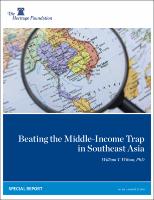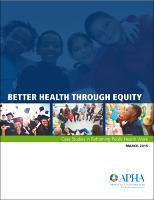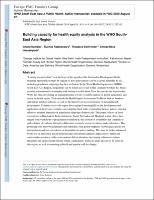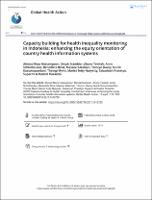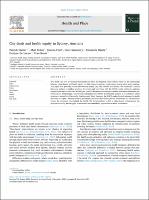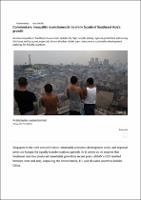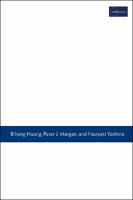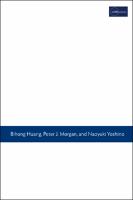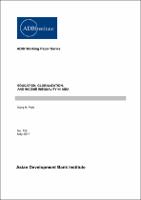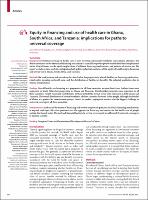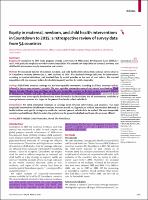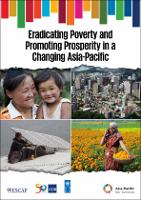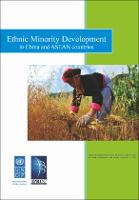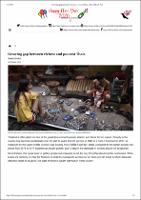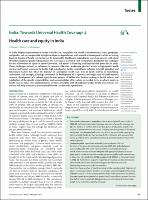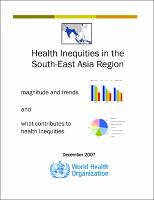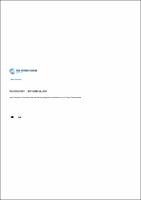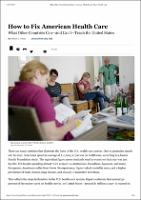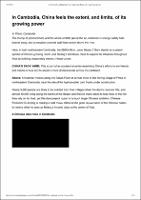Browsing 1.03.02 Economic, Social & Political Context by Title
Now showing items 11-30 of 55
-
Beating the Middle-Income Trap in Southeast Asia
(The Heritage Foundation, 2014)
Since 2000, Southeast Asia has had some of the fastest growing economies in the world. Indonesia’s economy has enjoyed 6 percent annual growth—but will its lack of infrastructure and its commodity dependence soon reveal some cracks in its economy? The remarkable growth in the Philippines will not last unless domestic investment is elevated. Thailand’s growth has stalled amid political turmoil, and it is currently in a classic credit bubble. Vietnam still generates impressive growth, but it has a banking problem, high inflation, and ubiquitous ... -
Better Health Through Equity: Case Studies in Reframing Public Health Work
(American Public Health Association, 2015)
The efforts chronicled in this series of case studies are not only designed to improve health outcomes, they are also poised to save the country billions in health care spending. According to one study published in 2009, more than 30 percent of direct medical costs faced by African Americans, Hispanics and Asian Americans can be tied to health inequi- ties. Because of inequitable access to care, these populations are sicker when they do find a source of care and incur higher medical costs. That 30 percent translates to more than $230 billion over ... -
Building capacity for health equity analysis in the WHO South-East Asia Region
(2019)
Leaving no one behind” is at the heart of the agenda of the Sustainable Development Goals, requiring that health systems be vigilant to how interventions can be accessed equitably by all, including population subgroups that face exclusion. In the World Health Organization (WHO) South-East Asia Region, inequalities can be found across and within countries but there has been a growing commitment to examining and starting to tackle them. Over the past decade in particular, WHO has been developing an armamentarium of tools to enable analysis of health ... -
Capacity building for health inequality monitoring in Indonesia: enhancing the equity orientation of country health information systems
(2018)
Background: Inequalities in health represent a major problem in many countries, including Indonesia. Addressing health inequality is a central component of the Sustainable Development Goals and a priority of the World Health Organization (WHO). WHO provides technical support for health inequality monitoring among its member states. Following a capacity-building workshop in the WHO South-East Asia Region in 2014, Indonesia expressed interest in incorporating healthinequality monitoring into its national health information system. Objectives: This ... -
City deals and health equity in Sydney, Australia
(2022-01)
City Deals’ are new governance instruments for urban development. Vast evidence exists on the relationship between urban factors and health equity, but little research applies a health equity lens to urban policy-making. This paper does precisely that for the Western Sydney City Deal (WSCD) in Australia. We conducted a critical discourse analysis of publicly available documents and interviews with the WSCD’s main architects, applying insights from relevant theories. We find ‘pro-growth’ discourse to encourage economic investment dominates any ... -
Commentary: Inequality looms beneath the shiny facade of Southeast Asia's growth
(CNA, 2017-04-23) -
Costa Ricans Live Longer Than Us. What’s the Secret?
(2021-08-30) -
Demystifying rising inequality in Asia
(Asian Development Bank Institute, 2019)
Income inequality is one of the most profound social, economic, and political challenges of our time. The gap between the rich and the poor has been regarded as a major concern for policy makers. This gap is at its highest level in decades for developed economies, while the inequality trend has been rising in many developing countries. In Asia, despite recent economic growth, income distribution has been worsening as well. This book contributes to the existing literature on inequality in Asia by overviewing the new trend of inequality in Asia and ... -
Demystifying rising inequality in Asia
(Asian Development Bank Institute, 2019)
Income inequality is one of the most profound social, economic, and political challenges of our time. The gap between the rich and the poor has been regarded as a major concern for policy makers. This gap is at its highest level in decades for developed economies, while the inequality trend has been rising in many developing countries. In Asia, despite recent economic growth, income distribution has been worsening as well. This book contributes to the existing literature on inequality in Asia by overviewing the new trend of inequality in Asia and ... -
Education, Globalization, and Income Inequality in Asia
(Asian Development Bank Institute, 2017-05)
This study considers how education and globalization affect income inequality in Asia, with unbalanced panel data. The evidence supports the validity of Kuznets’ inverted-U hypothesis for the connection between income level and income inequality. However, when more variables are integrated into the model, the consistency of the inverse U-shaped curve becomes weaker. The empirical results suggest that educational variables are highly influential in affecting income distribution. Our analysis indicates that a higher level of education achieved by ... -
Equity in financing and use of health care in Ghana, South Africa, and Tanzania: implications for paths to universal coverage
(The Lancet, 2012)
Background Universal coverage of health care is now receiving substantial worldwide and national attention, but debate continues on the best mix of financing mechanisms, especially to protect people outside the formal employment sector. Crucial issues are the equity implications of different financing mechanisms, and patterns of service use. We report a whole-system analysis—integrating both public and private sectors—of the equity of health-system financing and service use in Ghana, South Africa, and Tanzania. -
Equity in maternal, newborn, and child health interventions in Countdown to 2015: a retrospective review of survey data from 54 countries
(The Lancet, 2012)
Background Countdown to 2015 tracks progress towards achievement of Millennium Development Goals (MDGs) 4 and 5, with particular emphasis on within-country inequalities. We assessed how inequalities in maternal, newborn, and child health interventions vary by intervention and country. -
Eradicating Poverty and Promoting Prosperity in a Changing Asia-Pacific
(United Nations, 2017-03-01)
This report is produced under a renewed partnership between United Nations (ESCAP), ADB, and the United Nations Development Programme (UNDP) to support national and regional efforts to implement the 2030 Agenda for Sustainable Development. It explores five megatrends that will determine whether everyone will be able to thrive and fulfill their expectations for a better life in the future: regional economic cooperation and integration; rural–urban transitions; demographic changes; ICT access and connectivity; and demand for natural resources. It ... -
Ethnic Minority Development
(2013)
This paper was presented in the sixth China-ASEAN Forum on Social Development and Poverty Reduction, which was held on 26-27 September 2012 in Liuzhou, China. The forum was supported under the UNDP-IPRCC project. Southeast Asia and China together constitute nearly half of the total global ethnic minority population. This chapter will address the challenge of the development of ethnic minority groups in the ASEAN region, and China -
Growing gap between richest and poorest Thais
(the ASEAN Post, 2019-10-25) -
Health care and equity in India
(The Lancet, 2011)
In India, despite improvements in access to health care, inequalities are related to socioeconomic status, geography, and gender, and are compounded by high out-of-pocket expenditures, with more than three-quarters of the increasing financial burden of health care being met by households. Health-care expenditures exacerbate poverty, with about 39 million additional people falling into poverty every year as a result of such expenditures. We identify key challenges for the achievement of equity in service provision, and equity in financing and ... -
How Countries in Southeast Asia are Working Together to Accelerate Human Capital Development
(THE WORLD BANK, 2019) -
In Cambodia, China feels the extent, and limits, of its growing power
(Washington post, 2015)

